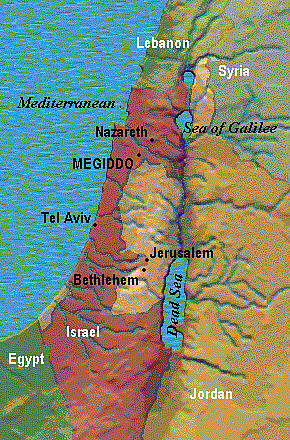|
|
||
|
Armageddon: (noun) from Ancient Greek Ἁρμαγεδών “hill of magiddo”
Book of Revelation prophesues that armies will gather gathering of for a great battle at the end times. The location of this final battle is given as Armageddon. There have been hundreds of books written about the battle of Armageddon, which is interpreted as either a literal or a symbolic event. The term is also used in a generic sense to refer to any end of the world scenario.The site is currently occupied by the town of Megiddo, a town located approximately 25 miles west-southwest of the southern tip of the Sea of Galilee in the Kishon River area of Israel. It was eventually conquered by Joshua and assigned to the tribe of Manasseh. Since then the valley has been a place of conflict. King Solomon’s cavalry was stationed there, ready to defend Israel’s northern borders from invaders. Many ancient battles, including some very important ones in the 15th century BC and one in 609 BC. The word Armageddon is derived from the Hebrew har məgiddô meaning "a mount at Megiddo". Not originally a hill, it was built up by many generations of people living and rebuilding on the same spot. |
||
|
Judaism The powerful Jewish imagery of Armageddon foreshadowed in Book of Revelation a time when Gentile kings of the world as represented by the first century Roman Empire would be solidly defeated by Israel’s God in his Jewish Christ. Through the judgement of God the Great Roman Empire was soon to be no more. Many modern writers have said that the Holocaust may have been the fulfillment of the prophecy. The Jews were almost totally destroyed and were saved at the last moment by something akin to divine intervention. Christianity Though the word Armageddon appears 12 times in the Old Testament, with no prophetic association, it occurs only once in the New Testament, in Revelation 16:16,where it seems to be a place for the gathering of nations in the last days at "the war of the great day of God, the Almighty". The traditional Christian viewpoint interprets this Bible prophecy figurtively as a symbol of the "great day of God, the Almighty" in which God's just and holy wrath is poured out against unrepentant sinners, led by Satan, in some final confrontation. |
 |
Armageddon is
the symbolic name given to this event based on scripture references
regarding divine obliteration of God's enemies. In the book of Judges
Megiddo is called the Valley
of Jehosaphat. Dispensational Christianity interprets this prophecy literally and expects that the fulfillment of prophecy will also be a campaign and not a specific battle, which will be fought in the Middle East. They mention the "hill of Megiddo" and other geographic locations such as "the valley of Jehoshaphat" and "the valley of the passengers", "Lord coming from Edom or Idumea, south ofJerusalem, when he returns from the judgment"; and Jerusalem itself. They conclude that it must take place at a specific time The invasion of Israel by the Northern Confederacy "will bring the Beast and his armies to the defense of Israel as her protector".After the destruction of the Beast at the Second Coming of Jesus, the is set up, in which Jesus and the saints will rule for a thousand years. Satan is then loosed "for a season" and goes out to deceive the nations, specifically, Gog and Magog. The army mentioned attacks the Saints in theNew Jerusalem, they are defeated by a judgment of fire coming down from Heaven |
 |
||
|
|
||